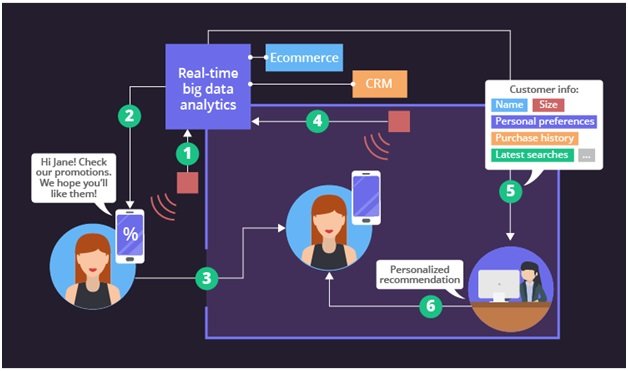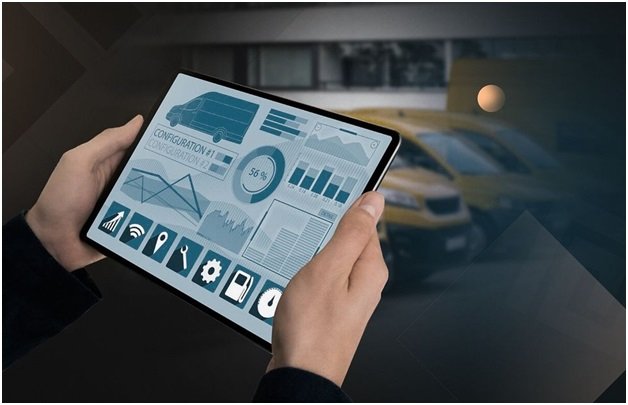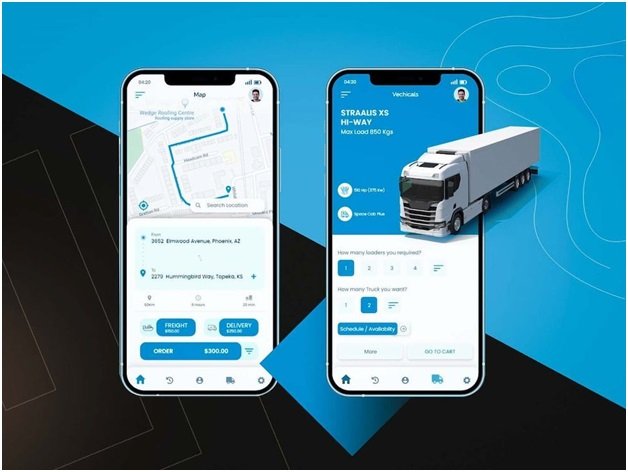
Words Abdul Rahman
In the digital age, businesses face a dual challenge: the abundance of data and the imperative to remain competitive. Big Data Implementation in Business has emerged as a transformative solution, empowering organizations to harness the vast amounts of data at their disposal for strategic advantage. This paradigm shift enables businesses to unlock valuable insights, streamline operations, and innovate quickly. From optimizing supply chains to enhancing customer experiences, big data applications are diverse and impactful. In this era of relentless competition and evolving consumer expectations, leveraging data analytics is not just a choice but an essential for survival and expansion. This blog gets into the dynamic realm of big data implementation in business, exploring its myriad applications and the transformative potential it holds for organizations across industries.
Demand Forecasting andInventory Optimization

In the realm of supply chain management, demand forecasting and inventory optimization play pivotal roles in ensuring operational efficiency and customer satisfaction. Leveraging big data analytics enables businesses to accurately predict demand patterns and optimize inventory levels to meet fluctuating market demands while minimizing excess stock and associated costs.
Utilizing Data Sources
| Data Source | Description |
| Historical Sales | Analyzing past sales data to determine trends and seasonality |
| Market Trends | Incorporating market trends and economic indicators |
| Customer Feedback | Integrating customer feedback and preferences into forecasts |
Advanced Forecasting Techniques
Implementing advanced forecasting methodologies, including:
- Machine Learning Models: Utilizing algorithms to analyze historical data and make accurate predictions.
- Time Series Analysis: Identifying patterns and trends in time-series data to forecast future demand.
- Predictive Analytics: Anticipating demand based on factors such as promotions, weather, and demographic shifts.
Optimizing Inventory Levels
By enhancing inventory levels based on demand forecasts, businesses can:
- Reduce Stockouts: Ensuring products are available when customers need them.
- Minimize Excess Inventory: Preventing overstock situations and associated costs.
- Improve Cash Flow: Allocating resources efficiently and reducing capital tied up in inventory.
In essence, leveraging big data for demand forecasting and inventory optimization empowers businesses to operate leaner, respond swiftly to market dynamics, and deliver superior customer experiences.
Real-Time Tracking AndTraceability Solutions

In the modern supply chain landscape, the ability to track and trace products in real time is essential for ensuring transparency, efficiency, and compliance with regulatory standards. Implementing big data in business lets firms execute robust tracking and traceability solutions that provide visibility into the shifting of goods throughout the supply chain, from production to delivery.
Utilizing Data Sources
| Data Source | Description |
| RFID Technology | Tracking products using RFID tags for real-time visibility |
| GPS Tracking | Monitoring the location of shipments in transit |
| Sensor Data | Collecting data on temperature, humidity, and other environmental factors |
Advanced Tracking Technologies
Implementing advanced tracking technologies, such as:
- Blockchain: Utilizing blockchain technology to create immutable records of product movement and transactions.
- IoT Sensors: Deploying IoT sensors to monitor conditions during transit and ensure product quality and integrity.
- Predictive Analytics: Analyzing tracking data to anticipate delivery times and optimize routes for faster and more efficient deliveries.
Benefits of Real-time Tracking
By implementing real-time tracking and traceability solutions, businesses can:
- Enhance Visibility: Gain real-time visibility into the entire supply chain, from manufacturing to delivery.
- Improve Efficiency: Streamline operations and reduce delays through proactive monitoring and intervention.
- Ensure Compliance: Meet regulatory requirements and demonstrate adherence to quality and safety standards.
In summary, leveraging big data for real-time tracking and traceability empowers businesses to operate more efficiently, mitigate risks, and meet the growing demands for transparency and accountability in today’s supply chain ecosystem.
Supplier Performance Analysis AndRisk Management

Evaluating supplier performance and managing associated risks are critical components of effective supply chain management. Through the utilization of big data analytics, businesses can assess supplier performance metrics, identify areas for improvement, and mitigate potential risks to ensure a reliable and resilient supply chain network.
Utilizing Data Sources
| Data Source | Description |
| Delivery Metrics | Tracking on-time delivery rates, lead times, and order accuracy |
| Quality Metrics | Assessing product quality, defects, and compliance with specifications |
| Financial Data | Analyzing supplier financial health and stability |
Performance Metrics and KPIs
Establishing key performance indicators (KPIs) to measure supplier performance, including:
- Supplier Scorecards: Creating scorecards to track performance across various metrics and benchmarks.
- Cost Metrics: Evaluating total cost of ownership, including prices, fees, and total landed costs.
- Quality Metrics: Assessing product quality, defect rates, and customer satisfaction levels.
Risk Identification and Mitigation
Utilizing big data analytics to identify and mitigate supplier-related risks, such as:
- Supply Chain Disruptions: Monitoring geopolitical events, natural disasters, and other external factors that may impact supplier operations.
- Financial Instability: Assessing supplier financial health and diversifying the supplier base to mitigate financial risks.
- Compliance Risks: Ensuring suppliers adhere to regulatory requirements and ethical standards to mitigate compliance risks.
By leveraging big data for supplier performance analysis and risk management, businesses can enhance supply chain resilience, optimize supplier relationships, and drive operational excellence in today’s competitive business environment.
Enhancing Customer Experience Through Data-Driven Logistics

In the modern era of e-commerce and heightened customer expectations, delivering exceptional customer experiences requires efficient and data-driven logistics operations. By utilizing big data analytics, businesses can boost their logistics processes to ensure timely deliveries, minimize shipping costs, and enhance overall customer satisfaction.
Utilizing Data Sources
| Data Source | Description |
| Order History | Analyzing past orders to identify trends and preferences |
| Delivery Tracking | Tracking shipment status and delivery times in real-time |
| Customer Feedback | Gathering feedback to understand pain points and areas for improvement |
Optimizing Delivery Routes
Utilizing data-driven algorithms to optimize delivery routes and schedules, considering factors such as:
- Traffic Patterns: Analyzing real-time traffic data to minimize delivery times and avoid congested routes.
- Geographic Data: Incorporating geographic information to optimize delivery routes based on proximity to customers.
- Demand Forecasting: Anticipating demand trends to allocate resources efficiently and reduce delivery lead times.
Dynamic Inventory Management
Implementing dynamic inventory management systems to ensure product availability and reduce stockouts, including:
- Demand Sensing: Using predictive analytics to anticipate demand fluctuations and adjust inventory levels accordingly.
- Safety Stock Optimization: Calculating optimal safety stock levels based on demand variability and lead times.
- Cross-Docking: Streamlining operations by bypassing storage and directly transferring goods from inbound to outbound shipments.
By leveraging big data for logistics optimization, businesses can deliver seamless and personalized experiences to customers, driving loyalty and competitive advantage in the marketplace.
Strategies For Leveraging Big Data InLast-Mile Delivery Optimization

Last-mile delivery presents unique challenges and opportunities for businesses striving to meet customer expectations in the final stage of the supply chain. By harnessing big data analytics, companies can implement strategies to optimize last-mile delivery processes, enhance efficiency, and ensure timely and cost-effective deliveries to end customers.
Utilizing Data Sources
| Data Source | Description |
| Geospatial Data | Mapping delivery locations and optimizing routes |
| Traffic Data | Analyzing real-time traffic conditions to minimize delays |
| Customer Preferences | Incorporating delivery preferences and time windows |
Route Optimization
Utilizing data-driven algorithms to optimize delivery routes, considering factors such as:
- Dynamic Routing: Adjusting routes in real-time based on traffic conditions and delivery priorities.
- Multi-Stop Optimization: Consolidating multiple deliveries into efficient routes to minimize mileage and fuel costs.
- Delivery Time Windows: Accommodating customer preferences for specific delivery time slots.
Fleet Management
Implementing data-driven fleet management solutions to:
- Vehicle Tracking: Monitoring vehicle locations and statuses in real-time to ensure efficient deployment.
- Maintenance Optimization: Predictive maintenance scheduling to minimize vehicle downtime and disruptions.
- Driver Performance Analysis: Assessing driver performance and optimizing routes based on historical data.
Customer Communication
Utilizing data analytics to enhance communication with customers, including:
- Delivery Notifications: Providing real-time updates on delivery status and estimated arrival times.
- Delivery Preferences: Allowing customers to customize delivery options and preferences for convenience.
- Feedback Collection: Gathering feedback to continuously improve the delivery experience and address any issues.
By leveraging big data for last-mile delivery optimization, businesses can streamline operations, reduce costs, and exceed customer expectations, ultimately driving satisfaction and loyalty in the final stage of the supply chain.
Conclusion:
In conclusion, the utilization of Big Data Implementation in Business revolutionizes supply chain management, optimizing operations from procurement to last-mile delivery. By leveraging data analytics, companies gain insights into demand forecasting, inventory management, supplier performance, logistics optimization, and customer experiences. These strategic applications not only enhance efficiency but also mitigate risks and drive competitiveness. Big data implementation in business empowers organizations to make knowledgeable decisions, adjust to market dynamics, and deliver exceptional value across the supply chain, ensuring sustained success in today’s data-driven business.
About the Author

Abdul Rahman is a prolific author, renowned for his expertise in creating captivating content for a diverse range of websites. With a keen eye for detail and a flair for storytelling, Abdul crafts engaging articles, blog posts, and product descriptions that resonate with readers across 400 different sites. His versatile writing style and commitment to delivering high-quality content have earned him a reputation as a trusted authority in the digital realm. Whether he’s delving into complex topics or simplifying technical concepts, Abdul’s writing captivates audiences and leaves a lasting impression.








